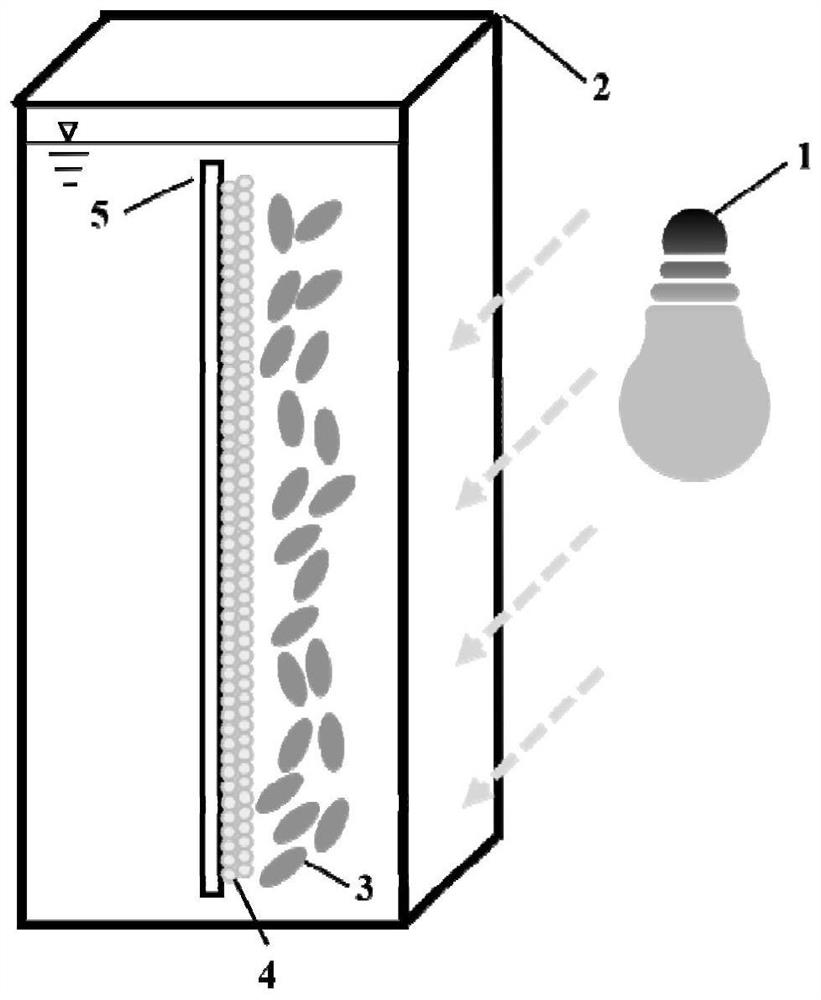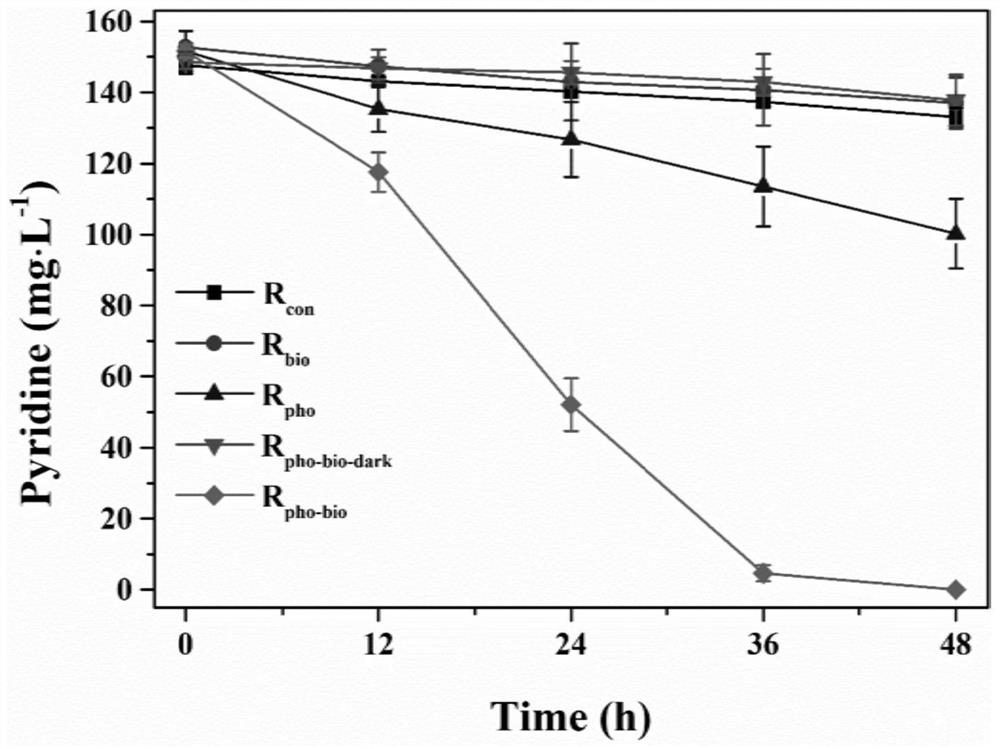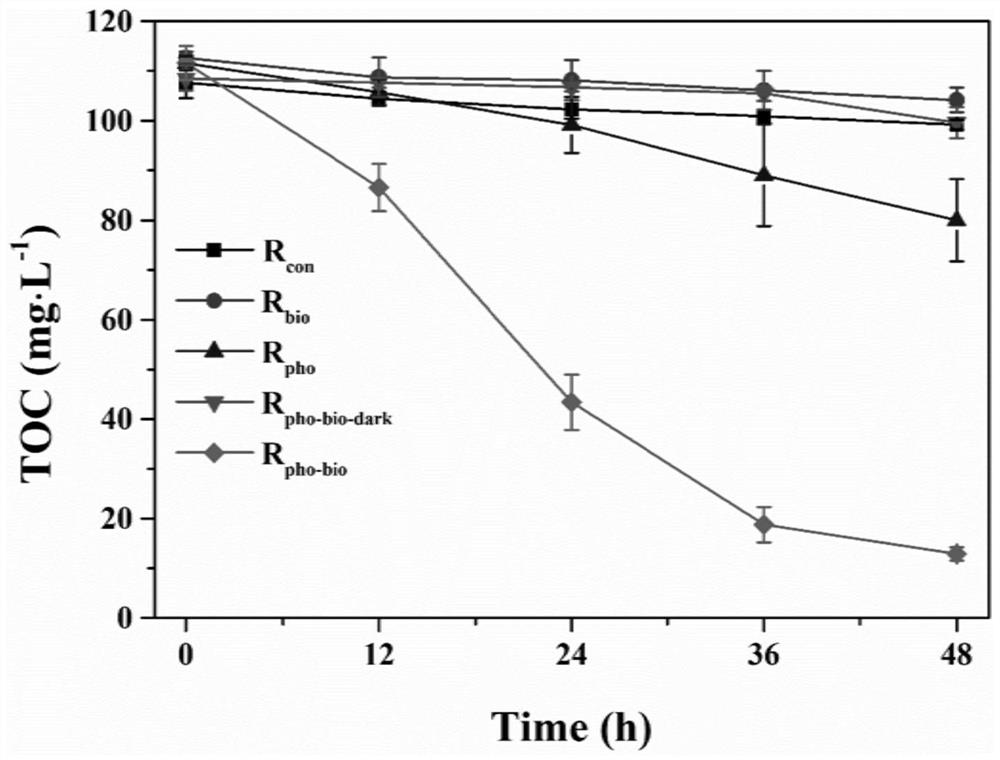Method for biological enhancement treatment of refractory organic pollutants with photo-excited hole as electron acceptor
A technology of organic pollutants and electron acceptors, applied in sustainable biological treatment, biological water/sewage treatment, water pollutants, etc., can solve the problems of low biodegradation technology load, difficult catalyst recovery, high cost, and achieve efficient removal ability, improve catalytic efficiency, and avoid the effect of recombination
- Summary
- Abstract
- Description
- Claims
- Application Information
AI Technical Summary
Problems solved by technology
Method used
Image
Examples
Embodiment 1
[0053] In this embodiment, the method for biologically enhanced treatment of refractory organic pollutants based on photoexcited holes as electron acceptors includes the following operations:
[0054] Schematic diagram of the photo-excited hole-enhanced bioreactor figure 1 As shown, the enhanced biological system is fixed by loading BiVO 4 The carbon paper of the / FeOOH composite semiconductor material is immersed in the quartz reactor 2, the size of the quartz reactor is 4.5×4.5×7.5 cm, and the volume is 150 mL.
[0055] The present invention adopts semiconductor immobilization technology to BiVO 4 / FeOOH compound semiconductor material 4 was immobilized on a carbon paper support (CP, 4 × 4 cm) to form BiVO 4 / FeOOH@CP; then by inoculating anaerobic sludge into the reactor in advance, using the sludge domestication, the BiVO4 / FeOOH composite semiconductor surface is loaded with biofilm 3, and a photo-excited hole-enhanced biological system is constructed.
[0056] Specific...
Embodiment 2
[0064] This example is basically the same as Example 1. In actual operation, pyridine simulated wastewater is added to the light-excited hole-enhanced biological system, and the sequential batch degradation is carried out in a period of two days. Pyridine simulated wastewater contains pyridine, buffer solution, inorganic salts, trace elements, etc.
[0065] Different reactors are configured according to the method in Example 1, and different experimental groups are set: the reactor configured with blank carbon paper to operate under light but not loaded with biofilm is named R con ; The reactor configured with blank carbon paper to operate under light and loaded with biofilm is named R bio ; A reactor configured with semiconducting materials operating under light but not loaded with biofilm is named R pho ; A reactor configured with semiconducting material and loaded with biofilm but not operated under light is named R pho-bio-dark ; The reactor configured with semiconducting ...
Embodiment 3
[0073] In this embodiment, different masking agents are used to explore the role of photo-excited holes, superoxide radicals and hydroxyl radicals in photo-excited holes-enhanced biological systems.
[0074] Under the excitation of light, the semiconductor material generates photoexcited electron-hole pairs, and the photoexcited electron-hole pairs can generate superoxide radicals and hydroxyl radicals with oxygen and water. Such as Figure 5 As shown, different masking agents were used to explore the role of photo-excited holes, superoxide radicals and hydroxyl radicals in photo-excited holes-enhanced biological systems. Methanol (MET) and isopropanol (IPA) were used as masking agents for photo-excited holes and hydroxyl radicals, respectively. In order to explore the role of superoxide radicals in photo-excited holes-enhanced biological systems, the solution was filled with nitrogen (N 2 ) for 15 minutes to ensure the removal of possible dissolved oxygen in the system. Aft...
PUM
 Login to View More
Login to View More Abstract
Description
Claims
Application Information
 Login to View More
Login to View More - R&D
- Intellectual Property
- Life Sciences
- Materials
- Tech Scout
- Unparalleled Data Quality
- Higher Quality Content
- 60% Fewer Hallucinations
Browse by: Latest US Patents, China's latest patents, Technical Efficacy Thesaurus, Application Domain, Technology Topic, Popular Technical Reports.
© 2025 PatSnap. All rights reserved.Legal|Privacy policy|Modern Slavery Act Transparency Statement|Sitemap|About US| Contact US: help@patsnap.com



